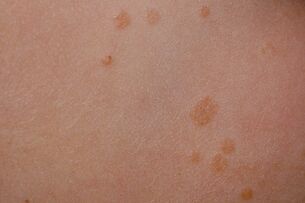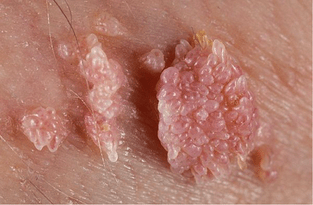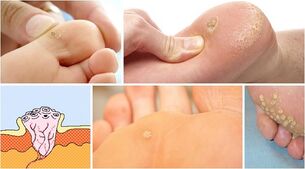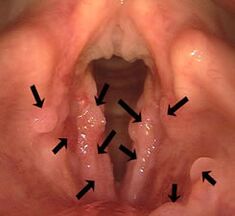The origin mechanism of papilloma
The appearance of specific types of tumors depends on the type of virus the patient has infected. Distinguish between low-carcinogenic strains and high-carcinogenic strains. In low-carcinogenic strains, growth will not pose a great risk to carriers. Papillomaviruses cause tumors, and their effects lead to excessive cell division, which results in gradual growth.
"Safe" papilloma usually occurs on the skin, and the most disturbing is the papilloma.This tumor usually causes a highly carcinogenic virus type. For women, the appearance of growths in the genital area can be dangerous for cervical cancer.

Common papilloma (warts)
One of the most common manifestations of HPV, usually called "warts. "Their appearance is usually due to contact and family transmission of low carcinogenic strains.
Warts usually occur on the fingers, hands, soles or feet.
On the surface, they look like small papillary tumors with a homogeneous structure. Ordinary papilloma is soft to the touch, and at the onset of the disease, its pigmentation is very weak: the color is actually no different from the color of the human body.
However, as the disease progresses, the growth will grow and begin to darken. Sometimes, hair will grow in the center of the wart.
Filamentous papilloma
This type of papilloma gets its name from the calf. This is because the tumor has grown on the surface of the skin. This growth is characterized by an elongated shape and has a size of about 5 mm. In most cases, the papilloma is located in the thinnest part of the skin:
- boobs;
- neck;
- Eyelids;
- Groin area;
- Underarms.
Filamentous papilloma is more common in patients over 45 years of age, but it sometimes occurs in young people.As the disease progresses, growth tends to increase.They gradually began to stretch.
The head of the papilloma is yellow or pink, with no obvious pigmentation. Keratinized tumors are rarely found. For trauma, no pain was observed. Several other places may appear at the site of the damaged filiform papilloma. If the growth is on the face, it is recommended to stop using scrubs or brushes. In the armpits, papilloma is often scratched by a razor, which may adversely affect the health of the patient.

Flat papilloma
This form of papilloma is also located on the skin, resembling small patches. Flat papillomas are light yellow in color and do not exceed 1-2 mm in size. Structurally, it grows densely and its roots are located under the skin. Therefore, pain may occur when damaged or pressurized. Also, this structural feature sometimes leaves scars after removing deposits.
Typical symptoms that accompany flat papilloma:
- Redness of the skin around the growth;
- Itching;
- Pain to touch;
- Inflammation.
Usually, the growth appears on the face or hands, but sometimes it appears on the genitals. In women, they are usually located in the labia majora, in men, they are located in the scrotum or anus. Flat papilloma will increase in size rapidly and bleed when traumatized.
Genital warts

These growths are usually located in the groin or mucosa. They are only caused by HPV strains that occur during unprotected sex. What they play most often is
- vagina;
- vulva;
- Cervix;
- Anal area;
- Scrotum;
- The penis.
The growth is similar to fine nipples, they are as small as -2-3 mm. Generally, viruses are not limited to the appearance of a single tumor. Warts are characterized by multiple growths at once and then gradually merge with each other. The tumor size grows rapidly. At this time, their shape began to resemble cauliflower inflorescences.
Genital warts are considered to be one of the most dangerous types of papilloma.In addition to the fact that these growths can degenerate into malignant tumors, infections usually combine with them. In addition, tumors are prone to recurrence after resection, so patients must be checked regularly to control the HPV concentration.
In rare cases, a con-process can be formed on internal organs such as the stomach wall or rectal area. In this case, it is impossible to self-diagnose whether there is a tumor. The lack of specific symptoms may become a problem in disease diagnosis and treatment.
Lewandowski-Lutz Papilloma
A rare type of papilloma. In most cases, they occur on the feet and hands. A distinctive feature of the product is uneven edges. They are usually brown, but sometimes they can have a deep red color. This disease may also lead to the transformation of tumors into malignant tumors, so patients should seek medical attention as soon as possible.

Plantar warts
These increases are more typical in children and adolescents and rarely occur in adulthood. It is considered to be a common response of the human body to decreased immunity, accompanied by uncomfortable shoes damage to the soles. Unlike ordinary calluses, warts are rough and have jagged edges. Likewise, the skin pattern is clearly visible on the callus.
Plantar warts are characterized by a small spot on the skin surface and a large base under the skin. Usually, it will be completely keratinized due to constant wear while walking. Over time, growth accelerates and squeezing or touching them can cause discomfort and pain.
Due to the nature of the structure, warts are difficult to remove from the skin because the warts are mostly located inside the skin. Therefore, after removal, sutures are usually required, and scars may be left at the surgical site.
Juvenile papilloma
Most infections occur in young children under 5 years of age, because infections usually occur during childbirth. If a pregnant woman is a carrier of papillomavirus and has genital warts in the vaginal area, then the child is very likely to be infected.

Juvenile papilloma on the skin is not dangerous. However, they may also be located in the throat, which may cause the baby to have difficulty breathing. In the initial stage, no signs of disease were observed. After a while, the following symptoms appeared:
- A lump in the throat;
- Difficulty swallowing saliva or food;
- Impaired respiratory function.
In older children, the voice may change, which is a typical sign of ligament damage. Papilloma may grow and trigger an asthma attack, which may one day stop breathing completely.
Papillomatosis
Papillomatosis is a type of tumor that increases dramatically and spreads throughout the body. It is also called generalized papilloma virus. Usually, a large number of papillomas are found on the hands and face of the genital area. Papillomatosis occurs in mucosal areas or internal organs and is potentially dangerous to humans.
Most commonly, when juvenile papilloma appears in the throat area, papillomatosis is mentioned. They are those who tend to overgrow.

Conclusion
Although there are relatively safe forms of papilloma, each type of papilloma requires regular examination by a specialist. This will help control its growth and quickly remove it if necessary. In addition, it is important to remember that the presence of a tumor is an indication of papillomavirus infection, which also requires prompt treatment.























